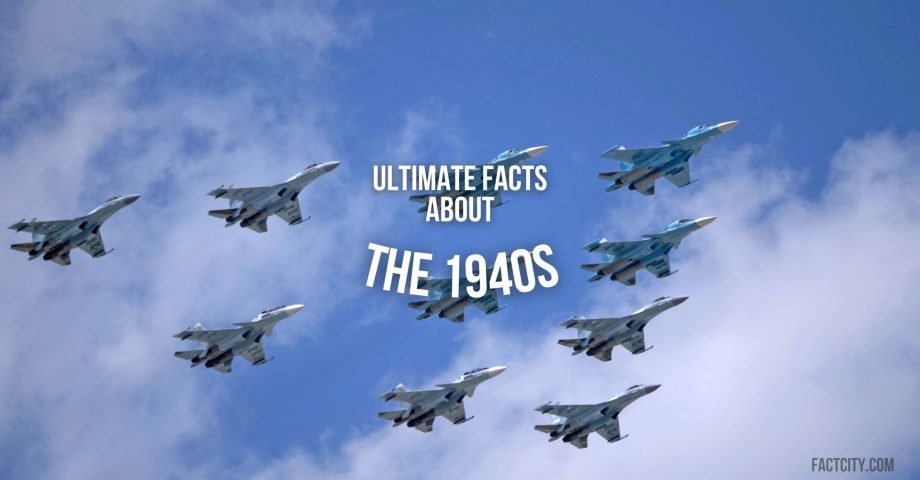36 Ultimate Facts About the 1940s
The 1940s were mostly marked with war and suffering but luckily there was light at the end of the tunnel in the form of heroism and endurance. Even though these years were dominated by World War II, many other happenings left a significant trace on this decade of transformation.
Technology advancements, rhythm and blues music, the beginnings of rock and roll, and fashion designed for the busy men and women were just a few of the goings-on in the 1940s. It was also a decade of astonishing films and actors, so in Humphrey Bogart’s words, these 40 interesting facts about the 1940s are looking at you kid!
1. Two pivotal wartime leaders took the stage at the start of the decade.
Two of the most important wartime leaders were appointed in 1940. Over in the UK, Winston Churchill was appointed prime minister. Across the Atlantic, Franklin D. Roosevelt was chosen President for the third time, breaking all US Presidential records.
2. The UK started suffering hard thanks to Nazi invasions.
In that same year, Nazi bombers started devastating the city of London in the Battle of Britain.
During the war, around 40,000 British civilians died between September 1940 and May 1941. Around half of those people were killed in the capital of London.
3. FDR set an even further Presidential record.
President Roosevelt defied all odds and won a fourth term in office in 1944, but sadly, he died just three months into it.
FDR was popular because he played a key role in helping defeat Nazi Germany, notably by working with other world leaders as allies and by strategically mobilizing the American economy – which was still in a state of recovery – to help support the war effort as much as possible.
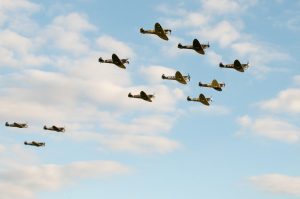
Spitfires flying in formation
4. A huge US landmark was built in the 40s.
On October 31st, 1941, the Mount Rushmore sculpture was completed.
It took an astonishing 14 years to complete the monument! It also cost the nation over $982,000 – that’s around $2 billion in modern money!
5. The US officially entered WWII in 1941.
Japan’s surprise attack on the US base in Pearl Harbor on December 7th, 1941, brought the United States into the war.
In fact, it was the day following the Pearl Harbour attack that the United States Congress officially declared war on Imperial Japan.
6. Russia and Japan declared a truce, but not for long.
The Soviet–Japanese Neutrality Pact, also known as the non-aggression pact, was signed on April 13th, 1941, two years after the termination of the Soviet-Japanese Border War.
The arrangement meant that the two nations fought against each other’s allies but not each other.
However, late in the war, in 1945, the Soviets canceled the pact and joined the war against Japan.
7. The Siege of Leningrad began in the early 40s.
The siege of Leningrad began on September 8th, 1941, as the Wehrmacht officially cut off the city’s last road in.
The Red Army didn’t remove the siege fully until at least 872 days later, on January 27th, 1944.
8. Casablanca was rushed for release.
The release of the famous film Casablanca was hurried because of real-life world events. Originally, the film was scheduled for release in the early part of 1943, but the film premiered at the Hollywood Theatre in New York City on November 26th, 1942.
9. FDR lowered the draft age for US citizens.
The draft age range at 21-35 set by The Selective Training and Service Act of 1940 was lowered in June 1942 by President Franklin D. Roosevelt to 18.
At that time, only men between the ages of 18 and 45 were drafted.

Franklin D Roosevelt
10. Mussolini fell from power.
On July 25th, 1943, Benito Mussolini, the Italian fascist dictator, was voted out of power by his Grand Council and arrested.
In 1945, he and his mistress tried to flee Switzerland but were promptly caught and executed near Lake Como. Their bodies were then strung up from their heels in Milan!
11. Eisenhower took the reins of the US military and more.
General Dwight D. Eisenhower was officially appointed as the Supreme Allied Commander, and he took control of the Allied forces. He went on to reach the five-star rank as a General of the Army.
In fact, Eisenhower eventually went one step further – his military record helped him become US President in 1953, in charge until 1961! He was a very popular public figure, though his Vice President – Richard Nixon – would become more infamous for reasons we’ll disclose in later fact files.
12. The US Pentagon was built in this decade.
The Pentagon building was completed on January 15th, 1943. The building is the headquarters of the US Department of Defense and also serves as a symbol of American strength and military power.
The Pentagon, of course, would also come under attack later in time during the September 11th terrorist attacks in 2001, when the World Trade Center buildings were brought down alongside.
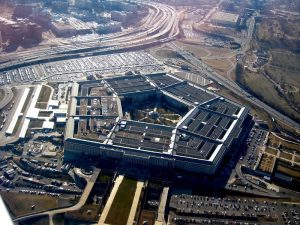
The Pentagon
13. Many fought back against Nazism.
Many of the remaining Jews in the Warsaw Jewish Ghetto decided to revolt against the Nazis. The first armed confrontation in the ghetto occurred in January 1943. Thankfully, Jewish people were eventually freed from camps due to the end of the war – but not before many lives were lost.
14. The Battle of Normandy oversaw the summer of ’44.
The Battle of Normandy lasted from June 1944 to August 1944. Operation Overlord (D-Day) began on June 6th, 1944, when 150,000 Allied troops successfully stormed the beaches of Normandy in France.
Soon, Paris was liberated as the troops entered the country.
15. Scuba diving saw big strides.
Jacques Cousteau and Emile Gagnan invented the Aqua-Lung (the modern regulator used in underwater Scuba diving) in France during the winter of 1942–1943. It’s since gone on to help influence modern diving apparatus over the decades.
16. An American musician never got to reach Paris – or anywhere, ever again.
On Christmas Day 1944, Glenn Miller, the famous American musician, was reported missing while on his way to perform for troops in Paris.
His airplane disappeared over the English Channel, and tragically, he was never seen again. That said, his music lives on, with his work remaining iconic from the period.
17. Poland found freedom from the Nazis.
In the summer of 1944, Poland was liberated from the Nazis by Soviet troops and the Polish Home Army. This was a fitting moment, as it’s widely agreed that Germany’s invasion of Poland effectively kick-started WWII.
18. Gandhi finally found freedom.
Indian independence leader Mahatma Gandhi was released from prison in 1944. He’d served time in prison for sedition or helping to incite resistance or rebellion against the state.
Sadly, Gandhi would be assassinated within the decade, too. More on this tragic event a little further down.
19. War came to an end.
World War II ended in 1945 as Allied and Soviet troops made their way towards Germany, liberating concentration camps along the way. Adolf Hitler had already committed suicide in a bunker, and the atrocities of Nazi Germany were, gradually, brought to their knees.
To this day, there are still concerns regarding Nazi generals and sympathizers who went unpunished.
20. The UN launched.
The United Nations was created after 50 nations signed the charter. The Charter was ratified on October 24th, and the first UN General Assembly was held in London on January 10th, 1946.
The UN formed as a response to the atrocities of WWII, in an attempt to help prevent any further large-scale devastation occurring in the future.
To this day, the UN is still welcoming members, with 193 countries sitting at the time of writing.
21. The US bombed Japan in retaliation for Pearl Harbor.
In August 1945, the US dropped two atomic bombs on Japan, killing 210,000 people—children, women, and men and bringing an end to the Pacific side of the war.
It’s still regarded as one of the bloodiest conflicts of the war and widely regarded as one of the most devastating moments for America throughout the period.
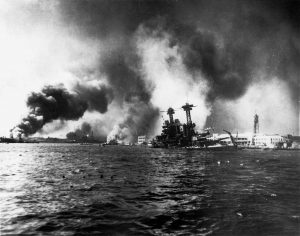
Pearl Harbor, December 7, 1941
22. Vietnam broke free from France.
On September 2nd, 1945, Vietnam gained its independence from France under the controversial leadership of Ho Chi Minh. The country had been part of the French colony, Indochina, since the late 1800s.
However, Vietnam would hit the headlines in years to come – the Vietnam War is said to have seen at least three million Vietnamese killed in the 1960s and 1970s.
23. Harry S. Truman took over America’s top job.
In 1945, after the death of FDR, Harry S. Truman became the United States President. He served as President of the United States of America until January 1953.
What’s especially interesting about Truman is that he didn’t actually have a middle name – he simply added the “S.” to sound more Presidential! It worked, at least!
24. BBC returned to broadcasting post-war.
In June 1946, the BBC resumed regular television broadcasting after being off the air for seven years.
However, it is important to note that the BBC played a crucial role during WWII as it served as an information service, as well as a service for monitoring the broadcasts from other nations.
Since then, it’s remained a staple source of news and entertainment for people all over the world – not just in the UK!
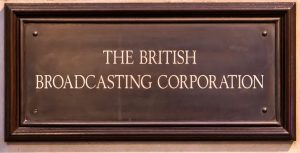
25. The computer age began.
On February 15th, 1946, ENIAC, the first programmable electronic computer, was officially unveiled at the University of Pennsylvania.
Believe it or not, programming the computer was actually a very difficult and manual job that could take days to complete!
26. Churchill made a rousing speech to help inspire Britons in light of Russian growth.
On March 5th, 1946, the former British Prime Minister, Winston Churchill, gave his “Iron Curtain” speech.
During the speech, he insisted that the US and Britain needed to be the protectors of peace against Soviet communism.
This would be prescient in years to come, as the Cold War would effectively begin between the US and Russia by the 1980s, with the former fearing the spread of communist ideals and the threat of potential nuclear war erupting between the nations looming overhead.
27. Ferrari’s sports lines kicked into gear.
In 1947, Ferrari began its production of sports cars. Only three years later, Ferrari began its legendary career in Formula 1.
Ferrari has since become a name synonymous with luxury sport cars and motor racing, with legends in F1 including Michael Schumacher, Niki Lauda, and Sebastian Vettel being just a few of the names who have gotten behind the wheels of their iconic red machines.

28. The transistor was invented and came into popular use.
The small semiconductor device called the transistor was invented at Bell Laboratories by William Shockley, Walter Brattain, and John Bardeen in 1947.
Essentially, the transistor helps to amplify power and signals. It’s a crucial part of electrical installations even to this day, so we certainly have the Bell Labs trio to thank for a lot!
29. Gandhi lost his life in the late 40s.
On January 30th, 1948, the Indian independence leader and pacifist Mahatma Gandhi was assassinated.
He was killed by a Hindu nationalist who shot him three times at close range. However, the world-famous civil rights activist’s legacy continued long past his death.
Some of Gandhi’s methods of resistance aren’t always looked upon with applause, but he remains a symbol of peace even decades on.
30. Polaroid photos made their debut in the late 1940s.
The Polaroid instant camera was demonstrated on February 21st, 1947 at a meeting of the Optical Society of America in New York City.
Polaroid photos are instant pictures that are printed just minutes after you took them. That might seem a bit dated nowadays, as we can take instant photos through phones and digital cameras!
However, the name Polaroid remains associated with physical snaps, and as such, it’s unlikely to fade away completely.
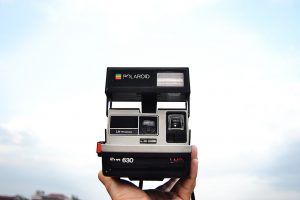
Polaroid camera
31. Health services changed for the better.
In 1948, Great Britain created the National Health Service, or NHS. The NHS is a publicly funded healthcare system. This healthcare system runs without charge, making the consultations with doctors, nurses, and even A&E treatment practically free!
It was the brainchild of Aneurin Bevan, and to this day, the service remains the biggest employer in the UK – and even the fifth-biggest employer globally.
32. NATO was formed shortly after the UN.
The North Atlantic Treaty Organization, NATO, was first established by the United States, Canada, and several Western European nations in 1949.
NATO initially sought to help unite Western forces against the perceived threat of Soviet forces potentially invading.
The organization still welcomes members to this day, with Finland joining as recently as 2023.
33. NASCAR debuted, changing motor racing forever.
In 1948, the first NASCAR race for modified stock cars was held in Daytona Beach. NASCAR stands for the National Association for Stock Car Auto Racing, founded by Bill France.
There have been many big motor racing stars to come out of NASCAR over the years, but Richard Petty is perhaps the most decorated. He won 200 races and claimed 123 pole positions!
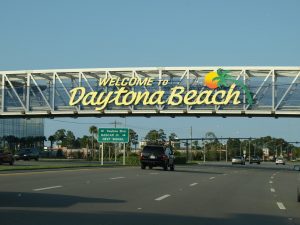
34. China became a republic under Mao Zedong.
On October 1st, 1949, Mao Zedong established the People’s Republic of China. Zedong would remain in charge until 1976, when he died.
This period brought China into a period of communist rule, with Zedong leading his country with a brutal fist.
35. The sitcom was born in the 40s.
In 1949, the live sitcom “The Goldbergs” debuted on CBS as one of the very first television sitcoms.
It ran until 1956 on US TV; however, did you know it actually started as a radio play as far back as the 1920s? It even became a stage play as of 1948.
It’s not to be confused with another US sitcom called The Goldbergs, which ran from 2013 to 2023, and was based in the 1980s.
36. Many big stars were born in the 1940s – literally and figuratively!
Some of the most famous movie stars in the 1940s were Clark Gable, Bob Hope, Bing Crosby, Humphrey Bogart, Abbott and Costello, Gary Cooper, Spencer Tracy, and James Cagney.
While the 1920s and 1930s saw “talkie” movies first come into their own, it was during the 1940s that the silver screen really became iconic.
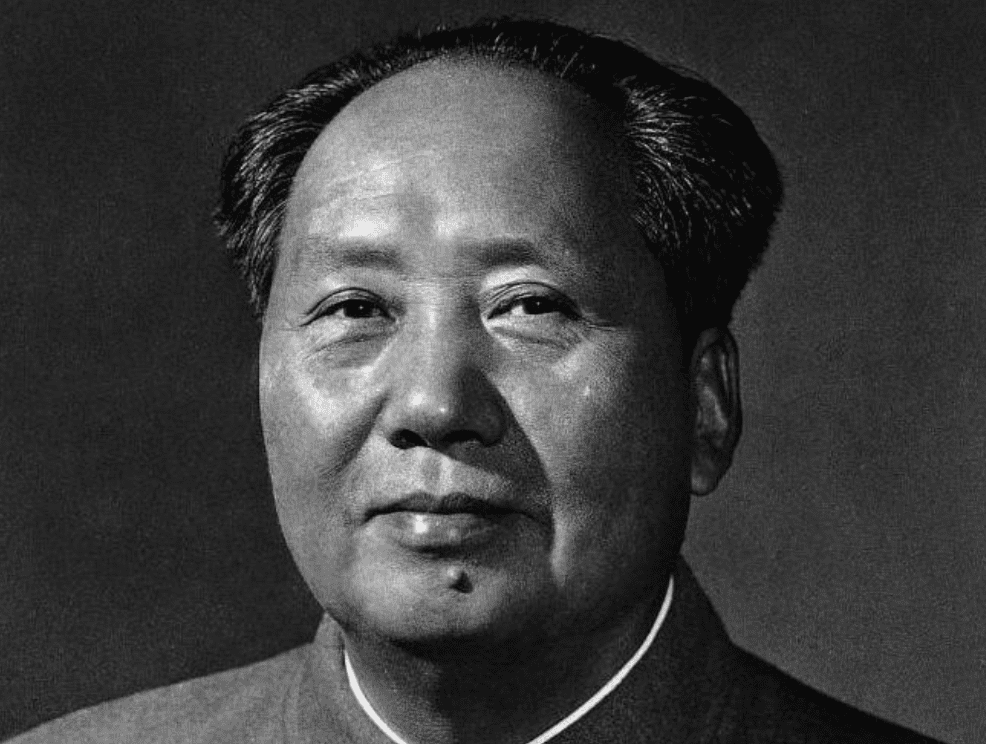
FAQs about the 1940s
What were the 1940s known as?
Due to the enormous impact WWII had on the decade, the 40s are widely known as the War Years.
What style of music was popular in the 40s?
In the 40s, many people enjoyed going to jazz clubs and listening to rhythm and blues.
What did people enjoy doing in the 1940s?
The 1940s was a very popular decade for sport - baseball really kicked off in a big way in the US, and it was also considered a 'party' decade towards the end.
Do you know any interesting facts about the 1940s? Share them in the comments below!
This page was last modified on April 12, 2024. Suggest an edit
